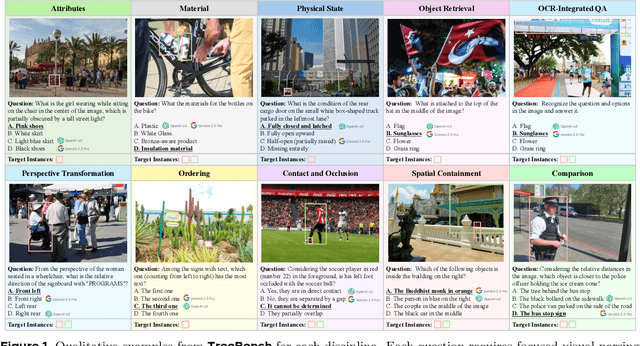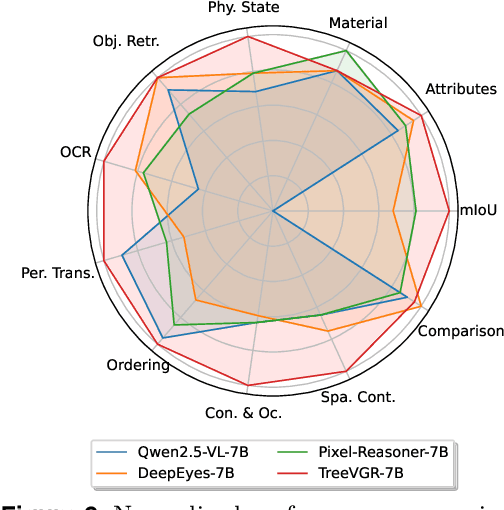Zhuochen Wang
MMaDA-Parallel: Multimodal Large Diffusion Language Models for Thinking-Aware Editing and Generation
Nov 18, 2025Abstract:While thinking-aware generation aims to improve performance on complex tasks, we identify a critical failure mode where existing sequential, autoregressive approaches can paradoxically degrade performance due to error propagation. To systematically analyze this issue, we propose ParaBench, a new benchmark designed to evaluate both text and image output modalities. Our analysis using ParaBench reveals that this performance degradation is strongly correlated with poor alignment between the generated reasoning and the final image. To resolve this, we propose a parallel multimodal diffusion framework, MMaDA-Parallel, that enables continuous, bidirectional interaction between text and images throughout the entire denoising trajectory. MMaDA-Parallel is trained with supervised finetuning and then further optimized by Parallel Reinforcement Learning (ParaRL), a novel strategy that applies semantic rewards along the trajectory to enforce cross-modal consistency. Experiments validate that our model significantly improves cross-modal alignment and semantic consistency, achieving a 6.9\% improvement in Output Alignment on ParaBench compared to the state-of-the-art model, Bagel, establishing a more robust paradigm for thinking-aware image synthesis. Our code is open-sourced at https://github.com/tyfeld/MMaDA-Parallel
Open-o3 Video: Grounded Video Reasoning with Explicit Spatio-Temporal Evidence
Oct 23, 2025Abstract:Most video reasoning models only generate textual reasoning traces without indicating when and where key evidence appears. Recent models such as OpenAI-o3 have sparked wide interest in evidence-centered reasoning for images, yet extending this ability to videos is more challenging, as it requires joint temporal tracking and spatial localization across dynamic scenes. We introduce Open-o3 Video, a non-agent framework that integrates explicit spatio-temporal evidence into video reasoning, and carefully collect training data and design training strategies to address the aforementioned challenges. The model highlights key timestamps, objects, and bounding boxes alongside its answers, allowing reasoning to be grounded in concrete visual observations. To enable this functionality, we first curate and build two high-quality datasets, STGR-CoT-30k for SFT and STGR-RL-36k for RL, with carefully constructed temporal and spatial annotations, since most existing datasets offer either temporal spans for videos or spatial boxes on images, lacking unified spatio-temporal supervision and reasoning traces. Then, we adopt a cold-start reinforcement learning strategy with multiple specially designed rewards that jointly encourage answer accuracy, temporal alignment, and spatial precision. On V-STAR benchmark, Open-o3 Video achieves state-of-the-art performance, raising mAM by 14.4% and mLGM by 24.2% on the Qwen2.5-VL baseline. Consistent improvements are also observed on a broad range of video understanding benchmarks, including VideoMME, WorldSense, VideoMMMU, and TVGBench. Beyond accuracy, the reasoning traces produced by Open-o3 Video also provide valuable signals for test-time scaling, enabling confidence-aware verification and improving answer reliability.
Grasp Any Region: Towards Precise, Contextual Pixel Understanding for Multimodal LLMs
Oct 22, 2025Abstract:While Multimodal Large Language Models (MLLMs) excel at holistic understanding, they struggle in capturing the dense world with complex scenes, requiring fine-grained analysis of intricate details and object inter-relationships. Region-level MLLMs have been a promising step. However, previous attempts are generally optimized to understand given regions in isolation, neglecting crucial global contexts. To address this, we introduce Grasp Any Region (GAR) for comprehen- sive region-level visual understanding. Empowered by an effective RoI-aligned feature replay technique, GAR supports (1) precise perception by leveraging necessary global contexts, and (2) modeling interactions between multiple prompts. Together, it then naturally achieves (3) advanced compositional reasoning to answer specific free-form questions about any region, shifting the paradigm from passive description to active dialogue. Moreover, we construct GAR-Bench, which not only provides a more accurate evaluation of single-region comprehension, but also, more importantly, measures interactions and complex reasoning across multiple regions. Extensive experiments have demonstrated that GAR-1B not only maintains the state-of-the-art captioning capabilities, e.g., outperforming DAM-3B +4.5 on DLC-Bench, but also excels at modeling relationships between multiple prompts with advanced comprehension capabilities, even surpassing InternVL3-78B on GAR-Bench-VQA. More importantly, our zero-shot GAR-8B even outperforms in-domain VideoRefer-7B on VideoRefer-BenchQ, indicating its strong capabilities can be easily transferred to videos.
Datasets and Recipes for Video Temporal Grounding via Reinforcement Learning
Jul 24, 2025Abstract:Video Temporal Grounding (VTG) aims to localize relevant temporal segments in videos given natural language queries. Despite recent progress with large vision-language models (LVLMs) and instruction-tuning, existing approaches often suffer from limited temporal awareness and poor generalization. In this work, we introduce a two-stage training framework that integrates supervised fine-tuning with reinforcement learning (RL) to improve both the accuracy and robustness of VTG models. Our approach first leverages high-quality curated cold start data for SFT initialization, followed by difficulty-controlled RL to further enhance temporal localization and reasoning abilities. Comprehensive experiments on multiple VTG benchmarks demonstrate that our method consistently outperforms existing models, particularly in challenging and open-domain scenarios. We conduct an in-depth analysis of training strategies and dataset curation, highlighting the importance of both high-quality cold start data and difficulty-controlled RL. To facilitate further research and industrial adoption, we release all intermediate datasets, models, and code to the community.
Traceable Evidence Enhanced Visual Grounded Reasoning: Evaluation and Methodology
Jul 10, 2025



Abstract:Models like OpenAI-o3 pioneer visual grounded reasoning by dynamically referencing visual regions, just like human "thinking with images". However, no benchmark exists to evaluate these capabilities holistically. To bridge this gap, we propose TreeBench (Traceable Evidence Evaluation Benchmark), a diagnostic benchmark built on three principles: (1) focused visual perception of subtle targets in complex scenes, (2) traceable evidence via bounding box evaluation, and (3) second-order reasoning to test object interactions and spatial hierarchies beyond simple object localization. Prioritizing images with dense objects, we initially sample 1K high-quality images from SA-1B, and incorporate eight LMM experts to manually annotate questions, candidate options, and answers for each image. After three stages of quality control, TreeBench consists of 405 challenging visual question-answering pairs, even the most advanced models struggle with this benchmark, where none of them reach 60% accuracy, e.g., OpenAI-o3 scores only 54.87. Furthermore, we introduce TreeVGR (Traceable Evidence Enhanced Visual Grounded Reasoning), a training paradigm to supervise localization and reasoning jointly with reinforcement learning, enabling accurate localizations and explainable reasoning pathways. Initialized from Qwen2.5-VL-7B, it improves V* Bench (+16.8), MME-RealWorld (+12.6), and TreeBench (+13.4), proving traceability is key to advancing vision-grounded reasoning. The code is available at https://github.com/Haochen-Wang409/TreeVGR.
HLV-1K: A Large-scale Hour-Long Video Benchmark for Time-Specific Long Video Understanding
Jan 03, 2025



Abstract:Multimodal large language models have become a popular topic in deep visual understanding due to many promising real-world applications. However, hour-long video understanding, spanning over one hour and containing tens of thousands of visual frames, remains under-explored because of 1) challenging long-term video analyses, 2) inefficient large-model approaches, and 3) lack of large-scale benchmark datasets. Among them, in this paper, we focus on building a large-scale hour-long long video benchmark, HLV-1K, designed to evaluate long video understanding models. HLV-1K comprises 1009 hour-long videos with 14,847 high-quality question answering (QA) and multi-choice question asnwering (MCQA) pairs with time-aware query and diverse annotations, covering frame-level, within-event-level, cross-event-level, and long-term reasoning tasks. We evaluate our benchmark using existing state-of-the-art methods and demonstrate its value for testing deep long video understanding capabilities at different levels and for various tasks. This includes promoting future long video understanding tasks at a granular level, such as deep understanding of long live videos, meeting recordings, and movies.
From Seconds to Hours: Reviewing MultiModal Large Language Models on Comprehensive Long Video Understanding
Sep 27, 2024



Abstract:The integration of Large Language Models (LLMs) with visual encoders has recently shown promising performance in visual understanding tasks, leveraging their inherent capability to comprehend and generate human-like text for visual reasoning. Given the diverse nature of visual data, MultiModal Large Language Models (MM-LLMs) exhibit variations in model designing and training for understanding images, short videos, and long videos. Our paper focuses on the substantial differences and unique challenges posed by long video understanding compared to static image and short video understanding. Unlike static images, short videos encompass sequential frames with both spatial and within-event temporal information, while long videos consist of multiple events with between-event and long-term temporal information. In this survey, we aim to trace and summarize the advancements of MM-LLMs from image understanding to long video understanding. We review the differences among various visual understanding tasks and highlight the challenges in long video understanding, including more fine-grained spatiotemporal details, dynamic events, and long-term dependencies. We then provide a detailed summary of the advancements in MM-LLMs in terms of model design and training methodologies for understanding long videos. Finally, we compare the performance of existing MM-LLMs on video understanding benchmarks of various lengths and discuss potential future directions for MM-LLMs in long video understanding.
 Add to Chrome
Add to Chrome Add to Firefox
Add to Firefox Add to Edge
Add to Edge